

Top 5 CNC Machines for your creativity. Innovative Building Processes in Architecture. Cursos 3D Rhino Valencia. En Rhinovalencia sabemos lo importante que es para ti como profesional poder hacer tangibles tus diseños para poderlos mostrar a tus clientes.
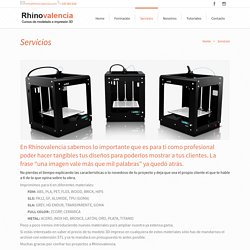
La frase “una imagen vale más que mil palabras” ya quedó atrás. No pierdas el tiempo explicando las características o lo novedoso de tu proyecto y deja que sea el propio cliente el que te hable a ti de lo que opina sobre tu obra. Imprimimos para ti en diferentes materiales: Poco a poco iremos introduciendo nuevos materiales para ampliar nuestra ya extensa gama. Si estás interesado en saber el precio de tu modelo 3D impreso en cualquiera de estos materiales sólo has de mandarnos el archivo con extensión STL y se te mandará un presupuesto lo antes posible. Muchas gracias por confiar tus proyectos a Rhinovalencia. Rhinovalencia pone a tu disposición todo su conocimiento adquirido a lo largo de los años. Desde el primer momento vas a tener asesoramiento completo en todo lo que necesites, tanto industrial como legal.
3d printing services. DISEÑO ESCANEADO E IMPRESIÓN 3D MURCIA - PLASTIC DREAMS. Lewihe 3D Printer. 3Dmatic. La Fabricación Aditiva conduce a una nueva revolución industrial. Fuente: Hallmark Nameplate Inc.
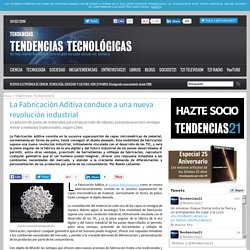
La Fabricación Aditiva, o Additive Manufacturing, como se conoce internacionalmente, consiste en la sucesiva superposición de capas micrométricas de material, normalmente en forma de polvo, hasta conseguir el objeto deseado. La consolidación del material en cada una de las capas se consigue de manera distinta según la tecnología. MX3D. Una casa de hielo para 'conquistar' Marte. El proyecto parte del descubrimiento de flujo de agua en el planeta Protegerá de la radiación y será un faro que brille durante la noche.
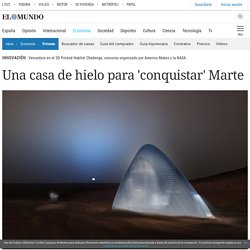
KamerMaker. Printing Material Distributions. Most digital design involves surface modeling.
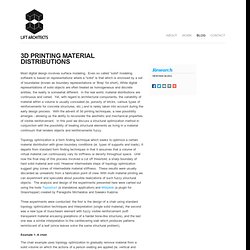
Even so called “solid” modeling software is based on representations where a “solid” is that which is enclosed by a set of boundaries (known as boundary representations or ‘Brep’ for short). While digital representations of solid objects are often treated as homogeneous and discrete entities, the reality is somewhat different. In the real world, material distributions are continuous and varied. Yet, with regard to architectural components, the variability of material within a volume is usually concealed (ie. porosity of bricks, various types of reinforcements for concrete structures, etc.) and is rarely taken into account during the early design process. With the advent of 3d printing techniques, a new possibility emerges - allowing us the ability to reconsider the aesthetic and mechanical properties of visible reinforcement.
Example 1: A chair. Mediated Matter. Neri Oxman and Steven Keating Functionally graded materials–materials with spatially varying composition or microstructure–are omnipresent in nature.
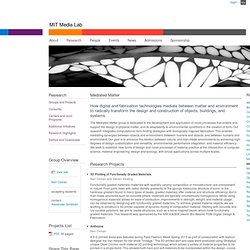
From palm trees with radial density gradients, to the spongy trabeculae structure of bone, to the hardness gradient found in many types of beaks, graded materials offer material and structural efficiency. But in man-made structures such as concrete pillars, materials are typically volumetrically homogenous. While using homogenous materials allows for ease of production, improvements in strength, weight, and material usage can be obtained by designing with functionally graded materials.
How 3D Printing Will Change Our World (Part II) Today, 3D Printing technology lives in the realm of small plastic tchotchkes. But economists, theorists, and consumers alike predict that 3D printers will democratize the act of creation and, in so doing, revolutionize our world. Which poses an interesting quandary: what will happen when we can print houses?
Last week, I discussed the incredible capabilities of 3D Printing in the not-so distant future: to quickly create homes for victims of disaster/poverty; to allow the architect the freedom to create curvy, organic structures once only dreamed of. But, if we look a little further afield, the possibilities are even more staggering. Printing 3D Buildings: Five tenets of a new kind of architecture / Neri Oxman. As a designer, architect, artist and founder of the Mediated Matter group at MIT’s Media Lab, Neri Oxman has dedicated her career to exploring how digital design and fabrication technologies can mediate between matter and environment to radically transform the way we design and construct our built world.
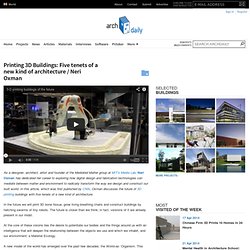
In this article, which was first published by CNN, Oxman discusses the future of 3D printing buildings with five tenets of a new kind of architecture. In the future we will print 3D bone tissue, grow living breathing chairs and construct buildings by hatching swarms of tiny robots. The future is closer than we think; in fact, versions of it are already present in our midst. At the core of these visions lies the desire to potentiate our bodies and the things around us with an intelligence that will deepen the relationship between the objects we use and which we inhabit, and our environment: a Material Ecology. Neri Oxman’s five tenets after the break… 1. Or consider the tree. 2. 3. 4.
How 3D Printing Will Change Our World. When the kids at NOTLabs first got their hands on a MakerBot Replicator, the ingenious 3D printer that can make just about anything you want, they quickly got down to business – making LEGO and Kinex connectors, that is.
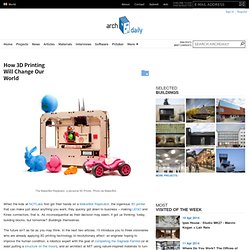
As inconsequential as their decision may seem, it got us thinking: today, building blocks, but tomorrow? Buildings themselves. The future isn’t as far as you may think. In the next two articles, I’ll introduce you to three visionaries who are already applying 3D printing technology to revolutionary effect: an engineer hoping to improve the human condition, a robotics expert with the goal of completing the Sagrada Familia (or at least putting a structure on the moon), and an architect at MIT using nature-inspired materials to turn the design world on its head.